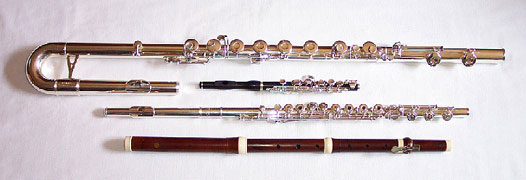Flutes
Piccolos, flutes, alto flutes, and bass flutes all produce sound in the same way. Air is blown across a hole which causes vibration of the air column as it travels down the length of the instrument. There are three pieces to a flute including the head joint, which contains the hole (top), body (middle), and foot joint (bottom).
Although very old flutes have been found around the world including the Neanderthal flute (43,000-82,000 years old), the modern flute developed from the recorder. The recorder, developed during the second half of the fourteenth century, was played with the mouthpiece in the mouth and the instrument held in front of the player. Recorders were built in a variety of sizes and had higher and lower ranges based on their size. Modern flutes are actually transverse flutes, meaning that they are played horizontally.
Although all of the flutes produce sound in the same way, they sound very different because of the range that they play. Piccolos are very small, play very high, and can sometimes produce a piercing sound. C flutes produce a clear, beautiful sound. Different notes are produced on the flute by covering more of the holes and making the air column longer (lower).
Alto and bass flutes are very large and produce a very dark covered sound. These bigger flutes are much longer than regular flutes and have to be shaped like the letter J in order for the player to put their mouth to the mouthpiece and still reach the keys to play different notes on the instruments.
Flutes can be heard in symphony orchestras, concert bands, jazz groups, and Latin American music groups. Flutes work very well as solo instruments or in groups, and seem to fit well into classical as well as modern music.
Study the image provided and listen to the sound sample of the flute to gain an understanding of this instrument.
![]() Listen to a sample of the flute:
Listen to a sample of the flute:
